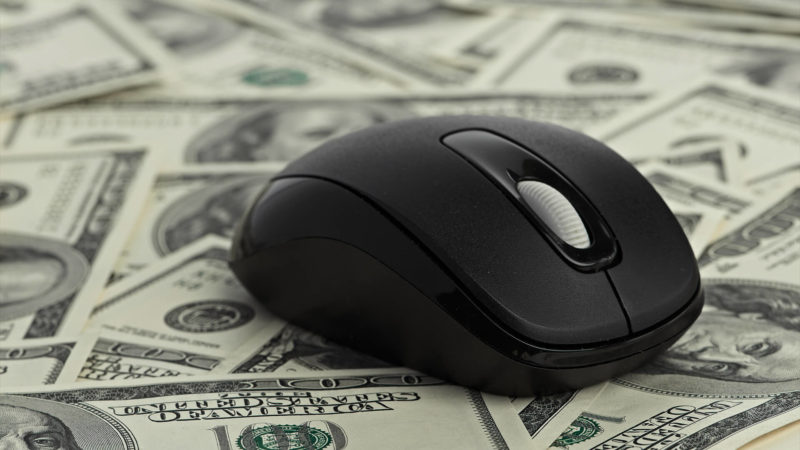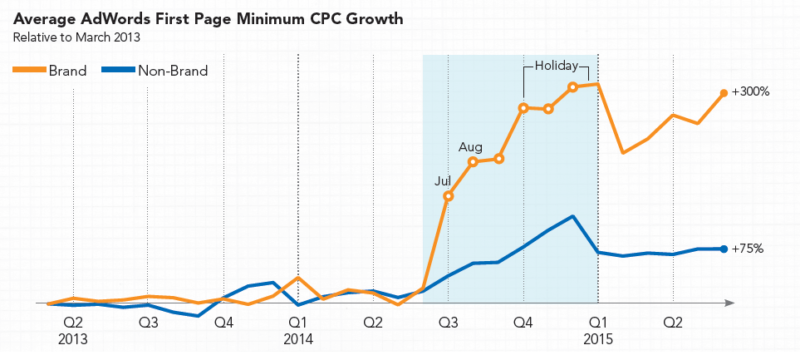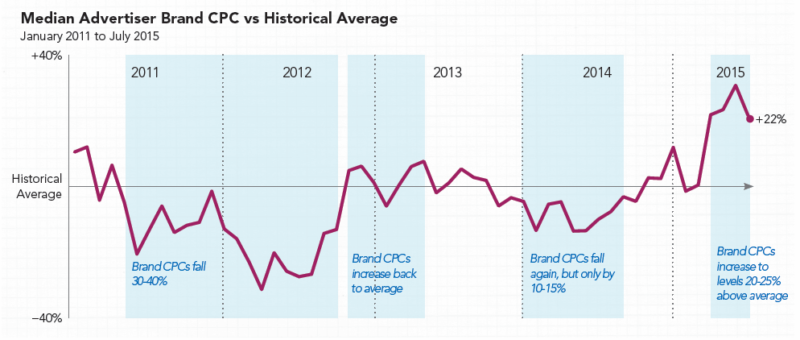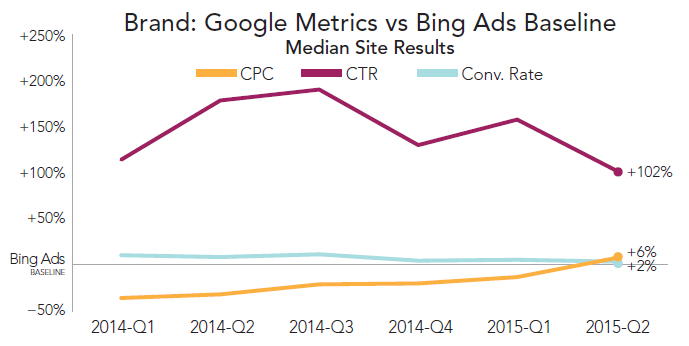AdWords Brand CPCs Rising? Here’s Why And What You Can Do About It
Many advertisers have noticed a recent surge in costs per click (CPCs) for their brand terms. Columnist Mark Ballard explores the issue.

One of the most valuable aspects of paid search benchmark data is its ability to help answer the question, “Is everyone seeing this, or is it just me?” Official data from the search engines themselves is usually sparse and can even be misleading, so it isn’t terribly helpful for this purpose.
Case in point: At a time when most industry reports are showing weak AdWords search click growth and rising average cost-per-click (CPC), Google is reporting that its clicks are up 18% year-over-year, while CPCs are down 11%.
We now know that YouTube “clicks” are having a huge impact on the limited metrics Google discloses publicly and are very likely completely flipping the narrative on what is really happening with paid search.
In my last post, I argued that Google search CPCs are in fact rising considerably, a result of Google raising minimum CPCs, which has led to declining search ad impressions, even when accounting for Product Listing Ads.
In the last few months, a new development in this story is the extent to which CPCs for advertisers’ own brand keywords have been driven higher under these circumstances. According to our research across the programs we manage at Merkle RKG, brand CPCs for Google search had risen 10% Y/Y in Q1 2015, compared with a 15% increase for non-brand CPCs. In Q2 2015, brand CPCs rose nearly 40% Y/Y, while non-brand CPC growth tapered to 4%.
What happened?
A Second Wave Of Minimum CPC Increases Hits Brand Keywords
When we chart the average estimated minimum CPC to appear on the first page of Google results for brand keywords, we see that minimum CPCs began to spike over July and August 2014.
Minimum CPCs rose further over the 2014 holiday season and then receded somewhat over Q1 2015, before rising again over Q2 2015. Average non-brand minimum CPCs followed a similar, albeit less severe, pattern over 2014 and into Q1 2015 but did not exhibit the Q2 2015 resurgence.
We have seen similar results with top of page minimum CPCs, which may be the more important metric for brand keywords because advertisers tend to rank highly for their own brand. The trend for either metric, though, suggests that Google has made changes that are driving up CPCs.
How Minimum CPCs Affect AdWords Auctions
Importantly, AdWords minimum CPCs, whether the minimum to appear on the first page of results or the minimum to appear at the top of the page above the organic results, are not solely the reflection of the level of competition in the market. Google can choose to set minimum CPCs however it sees fit. There’s no rule that it has to show 10 ads per page or three ads at the top of the page.
Even more important is the fact that AdWords minimum CPCs are not just informational — they play a direct role in the actual CPCs advertisers pay. As Google states on this AdWords help page for “Getting your ads above Google search results”:
The minimum Ad Rank required to appear above search results is generally greater than the minimum Ad Rank to appear beside search results. As a result, the cost-per-click (CPC) when you appear above search results could be higher than the CPC if you appear beside search results, even if no other advertisers are immediately below you. Although you may pay more per click, top ads usually have higher click-through rates[…].
To unwrap this statement, the top of page minimum CPC serves as a floor for the advertiser’s CPC, not just the advertiser’s bid. If there isn’t sufficient competition in the auction to drive your CPC high enough to match the top of page Ad Rank threshold, the threshold itself will raise your CPC. This means Google can raise advertiser CPCs by raising minimum CPCs, even if all bids in the auction are held constant.
A quick example: Say an advertiser bids $1 for its brand name and receives a quality score of 10. It faces a single competitor who also bids $1 but receives a quality score of 3.
Taking minimum CPCs out of the equation and doing the basic auction math would lead to the first advertiser paying $0.31 for their brand keyword (just enough to beat the competitor’s Ad Rank). If Google has set the top of page minimum CPC at $0.80, however, the first advertiser will pay: $0.80.
The bottom line is that Google really sets minimum CPCs, not minimum bids, which means your CPC can be driven up significantly even if neither you nor your competitors change bids.
It’s interesting (and a little confusing) that Google uses “Est. top of page bid” and “Est. first page bid” terminology in the AdWords UI, but the same metrics are more appropriately called topOfPageCpc and firstPageCpc within the AdWords API world.
AdWords Brand CPCs In Historical Perspective
In late 2012 and early 2013, advertisers faced a very similar landscape. Brand CPCs were rising sharply from one month to the next in a way that seemed beyond advertiser control. These increases were reversing a previous trend where brand CPCs had fallen 30–40% from the beginning of 2011 through August 2012.
Around that time, Google was introducing a number of ad extensions, including Enhanced Sitelinks in February 2012, which were giving top position ads much greater prominence and real estate on the page. This led to higher click-through rates and Quality Scores, which drove down CPCs, particularly for brand keywords.
Ultimately, Google began to normalize its Quality Score calculations for the effect ad extensions were having on advertiser click-through rates, and brand CPCs quickly regained their previous levels.
Looking at more recent history, we do see that brand CPCs had slipped below their historical average in mid-2014, but only by about 10–15% and during a seasonally slow period. If Google is making another “correction” of sorts, it may have overshot it, as brand CPCs are now running 20–25% above historical averages.
Another angle to this story is that brand keyword CPCs had long run much lower on Google than Bing before Google’s brand CPCs finally surpassed Bing’s in Q2 2015.
Advertisers had shown a willingness, although certainly not eagerness, to pay more for their brand if needed, and Google may simply be recognizing that and tweaking its algorithms accordingly.
What Can Advertisers Do?
Although Google wields more control over the AdWords auction than some might realize, advertisers can still take measures to lessen the pain of rising brand costs.
First, an easy one: Advertisers should enable all relevant and appropriate ad extensions for their brand and non-brand keywords. The use of ad extensions became an official part of Google’s Ad Rank in 2013 after its success in driving up ad click-through rates had driven down brand CPCs.
Essentially, Google now expects you to use extensions, and if you don’t, you can expect to see lower Ad Rank and higher CPCs. It’s also a safe bet that where Google sets top of page minimum CPCs when there is little or no competition is a direct function of Ad Rank.
Next, if your brand keywords have great copy, ad extensions and landing pages, but you’re still ending up paying more than you’d like, it may be worth dialing down bids to see if you can reduce your CPCs without losing many clicks.
That may seem obvious — lower your bids, lower your CPCs, but the key is that “Ad Rank and [CPC] thresholds are recomputed every page,” according to Google, and when a keyword’s Ad Rank is at the lowest end of its range, you’re likely to face higher top of page minimum CPCs.
By reducing your bids gradually, this is the first segment of traffic that you’ll knock below the minimum that is holding up its CPC, and in turn, inflating your overall click costs. Your click-through rate will suffer a bit from your ads being a little less prominent overall, but it may be worth it.
Finally, if you’re not having much luck keeping your brand keyword CPCs in check, it may be time to consider, or reconsider, the incremental impact that your brand ads are having in the larger context that includes your organic listings.
While most brand ad holdout tests show that brand ads lead to incremental clicks, if the cost side of the equation has changed significantly and you rank well organically for your brand, it may be time to simply reduce your brand ad investment.
Contributing authors are invited to create content for Search Engine Land and are chosen for their expertise and contribution to the search community. Our contributors work under the oversight of the editorial staff and contributions are checked for quality and relevance to our readers. The opinions they express are their own.
Related stories
New on Search Engine Land


